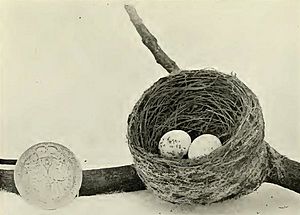Lord Howe fantail facts for kids
Quick facts for kids Lord Howe fantail |
|
|---|---|
 |
|
| Conservation status | |
| Scientific classification |
|
| Kingdom: | Animalia |
| Phylum: | Chordata |
| Class: | Aves |
| Order: | Passeriformes |
| Family: | Rhipiduridae |
| Genus: | Rhipidura |
| Species: | |
| Subspecies: |
†R. f. cervina
|
| Trinomial name | |
| Rhipidura fuliginosa cervina Ramsay, 1879
|
|
| Synonyms | |
|
|
The Lord Howe fantail was a small bird that lived on Lord Howe Island. This island is in the Tasman Sea, near Australia. It was also called the Lord Howe Island fantail or fawn-breasted fantail.
This bird was a type of fantail, a family of birds known for their fan-shaped tails. Sadly, the Lord Howe fantail is now extinct. This means it no longer exists anywhere in the world. It was a special kind of New Zealand fantail that only lived on Lord Howe Island. When an animal or plant only lives in one specific place, it is called endemic.
Contents
What Did the Lord Howe Fantail Look Like?
The Lord Howe fantail was a small bird. It looked a bit different from other fantails. Its belly and chest were a light cinnamon-brown color. Its throat was even lighter. Other fantails usually have a white throat with a dark line below it. The Lord Howe fantail did not have this dark line.
Some scientists thought it was a completely separate species. But now, it is known as a special type of the New Zealand fantail.
Where Did the Lord Howe Fantail Live?
This fantail only lived on Lord Howe Island. It made its home in the island's natural rainforests. These forests are warm and wet, perfect for many kinds of plants and animals.
How Did the Lord Howe Fantail Behave?
These birds were known for being very friendly. They were not afraid of people. You could often see them flying around buildings. They would even fly inside houses! They were looking for insects to eat.
Breeding and Life Cycle
The Lord Howe fantail built a special nest. It was shaped like a cup. The nest was made from soft materials like old wood fibers and grass. They used cobwebs to hold it all together. The inside was lined with fine grass to make it cozy.
They usually built their nests on a flat tree branch. A female fantail would typically lay three eggs. Sometimes, she would lay two eggs instead.
Why Did the Lord Howe Fantail Disappear?
In 1909, many Lord Howe fantails lived on the island. They were very common. But then, something terrible happened. In June 1918, a ship called the SS Makambo got stuck near the island. Black rats were accidentally brought to the island from this ship.
These rats quickly spread across Lord Howe Island. They hunted the native birds, including the fantail. The birds on the island had never faced predators like rats before. They did not know how to protect themselves or their nests.
By 1924, people reported that the fantails were "practically wiped out." After that, no one ever saw a Lord Howe fantail again. The last one likely died around 1925. The fantail was one of many unique animals on Lord Howe Island that disappeared because of the rats.
Images for kids




